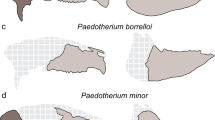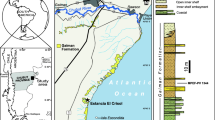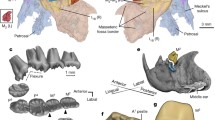Abstract
The Stagodontidae include the largest metatherians known from the Cretaceous of North America. Of the recognized species of the stagodontid genus Eodelphis, E. cutleri is larger and has a more robust dentary, more inflated premolars, and third premolars specialized for crushing, as opposed to the more gracile E. browni. These differences have led to the hypothesis that an E. cutleri-like ancestor gave rise to Didelphodon—another, mostly younger, stagodontid, which has been interpreted as a durophagous predator-scavenger. If correct, E. cutleri would be expected to show more morphological adaptation toward durophagy than E. browni does. Here, we describe two new dentary fossils referable to E. browni and test the evolutionary hypothesis by applying beam theory to estimate bending force capabilities of 22 dentaries of Cretaceous stagodontids and other metatherians. The resulting diversity of bending force profiles of the sampled dentaries implies that Cretaceous metatherians had a wide range of feeding behaviors. Among the stagodontids, E. cutleri has a mediolateral bending force profile of the dentary that is more similar to that of Didelphodon than it is to that of E. browni; whereas its dorsoventral bending force profile is more similar to that of E. browni. These results indicate that anteriorly the dentary of E. cutleri was capable of resisting high torsional stresses from hard-object feeding but lacked other dorsoventral buttressing associated with exceptionally high bite forces of Didelphodon. Our results imply that some morphological changes associated with durophagy evolved twice within this clade, independently in E. cutleri and Didelphodon.






Similar content being viewed by others
References
Benton MJ (1990) Scientific methodologies in collision: the history of the study of the extinction of the dinosaurs. Evol Biol 24:371–400
Biknevicius AR, Ruff CB (1992a) The structure of the mandibular corpus and its relationship to feeding behaviours in extant carnivorans. J Zool 228(3):479–507
Biknevicius AR, Ruff CB (1992b) Use of biplanar radiographs for estimating cross-sectional geometric properties of mandibles. Anat Rec 232(1):157–163
Binder WJ, Cervantes KS, Meachen JA (2016) Measures of relative dentary strength in Rancho La Brea Smilodon fatalis over time. PLoS One. https://doi.org/10.1371/journal.pone.0162270
Bois J, Mullin SJ (2017) Dinosaur nest ecology and predation during the Late Cretaceous: was there a relationship between Upper Cretaceous extinction and nesting behavior? Hist Biol. https://doi.org/10.1080/08912963.2016.1277423
Brown B (1997) Miocene hominoid mandibles: functional and phylogenetic perspectives. In: Begun DR, Ward CV, Rose MD (eds) Function, Phylogeny and Fossils: Miocene Hominoid Evolution and Adaptation. Plenum, New York, pp 153–171
Carneiro LM, Oliveira ÉV (2017) Systematic affinities of the extinct metatherian Eobrasilia coutoi Simpson, 1947, a South American early Eocene Stagodontidae: implications for “Eobrasiliinae.” Rev Brasil Paleontol 20(3):355–372
Chen M, Wilson GP (2015) A multivariate approach to infer locomotor modes in Mesozoic mammals. Paleobiology 41(2):280–312
Cifelli RL (1993) Early Cretaceous mammals from North America and the evolution of marsupial dental characters. Proc Natl Acad Sci USA 90:9413–9316
Cifelli RL, Eaton JG (1987) Marsupial from the earliest Late Cretaceous of the western U.S. Nature 325:520–522
Cifelli RL, Eberle JJ, Lofgren DL, Lillegraven JA, Clemens WA (2004) Mammalian biochronology of the latest Cretaceous. In: Woodburne MO (ed) Late Cretaceous and Cenozoic Mammals of North America: Biostratigraphy and Geochronology. Columbia University Press, New York, pp 21–42
Clemens WA (1966) Fossil mammals of the type Lance Formation, Wyoming. Part II. Marsupialia. Univ Calif Publ Geol Sci 62:1–122
Clemens WA (1968) A mandible of Didelphodon vorax (Marsupialia, Mammalia). Los Angeles County Mus Nat Hist Contrib Sci 133:1–11
Cohen JE (2017) Earliest divergence of stagodontid (Mammalia: Marsupialiformes) feeding strategies from the Late Cretaceous (Turonian) of North America. J Mammal Evol. https://doi.org/10.1007/s10914-017-9382-0
Crompton AW, Kielan-Jaworowska Z (1978) Molar structure and occlusion in Cretaceous therian mammals. In: Butler PM, Joysey KA (eds) Studies on the Development, Structure, and Function of Teeth. Academic Press, New York, pp 249–287
Daeling DJ, Grine FE (2006) Mandibular biomechanics and the paleontological evidence for the evolution of human diet. In: Ungar PS (ed) Evolution of the Human Diet: The Known, the Unknown, and the Unknowable. Oxford University Press, Cary, pp 77–105
DeMar DG Jr, Breithaupt BH (2006) The nonmammalian vertebrate microfossil assemblages of the Mesaverde Formation (Upper Cretaceous, Campanian) of the Wind River and Bighorn basins, Wyoming. Bull New Mex Mus Nat Hist Sci 35:33–53
Drees NM, Mhyr DW (1981) The Upper Cretaceous Milk River and Lea Park formations in southeastern Alberta. Bull Canadian Petroleum Geol 29(1):42–74
Dumont ER, Herrel A (2003) The effects of gape angle and bite point on bite force in bats. J Exp Biol 206:2117–2123
Eaton JG, Cifelli RL (1988) Preliminary report on Late Cretaceous mammals of the Kaiparowits Plateau, southern Utah. Contrib Geol Univ Wyo 26(2):45–55
Evans AR (2013) Shape descriptors as ecometrics in dental ecology. Hystrix, Ital J Mammal. https://doi.org/10.4404/hystrix-24.1-6363
Fiorillo AR (1989) The vertebrate fauna from the Judith River Formation (Late Cretaceous) of Wheatland and Golden Valley counties, Montana. Mosasaur 4:127–142
Fox RC (1971) Marsupial mammals from the early Campanian Milk River Formation, Alberta, Canada. In: Kermack DM, Kermack KA (eds) Early Mammals. Suppl. No. 1, Zool J Linn Soc 50:145–164
Fox RC (1979) Mammals from the Upper Cretaceous Oldman Formation, Alberta. Can J Earth Sci 16:91–102
Fox RC (1981) Mammals form the Upper Cretaceous Oldman Formation. V. Eodelphis Matthew, and the evolution of Stagodontidae (Marsupialia). Can J Earth Sci 18:350–365
Fox RC, Naylor BG (1986) A new species of Didelphodon Marsh (Marsupialia) from the Upper Cretaceous of Alberta, Canada: paleobiology and phylogeny. Neues Jahrbuch für Geologie und Paläontologie Abhandlungen 172:357–380
Fox RC, Naylor BG (1995) The relationships of the Stagodontidae, primitive North American Late Cretaceous mammals. In: Sun A, Wang Y (eds) Sixth Symposium on Mesozoic Terrestrial Ecosystems and Biota. China Ocean Press, Beijing, pp 247–250
Fox RC, Naylor BG (2006) Stagodontid marsupials from the Late Cretaceous of Canada and their systematic and functional implications. Acta Palaeontol Pol 51(1):13–36
Fox RC, Scott C, Bryant HN (2007) A new, unusual therian mammal form the Upper Cretaceous of Saskatchewan, Canada. Cret Res 28:821–829
Gill PG, Purnell MA, Crumpton N, Robson Brown K, Gostling NJ, Stampanoni M, Rayfield EM (2014) Dietary specializations and diversity in feeding ecology of the earliest stem mammals. Nature. https://doi.org/10.1038/nature13622
Grossnickle DM (2017) The evolutionary origin of jaw yaw in mammals. Sci Reports. https://doi.org/10.1038/srep45094
Grossnickle DM, Polly PD (2013) Mammal disparity decreases during the Cretaceous angiosperm radiation. Proc R Soc B 280:20132110. https://doi.org/10.1098/rspb.2013.2110
Grossnickle DM, Newham E (2016) Therian mammals experience an ecomorphological radiation during the Late Cretaceous and selective extinction at the K–Pg boundary. Proc R Soc B 283:20160256. https://doi.org/10.1098/rspb.2016.0256
Herring SW, Herring SE (1974) The superficial masseter and gape in mammals. Am Nat 108(962):561–576
Horner J (1999) Egg clutches and embryos of two hadrosaurian dinosaurs. J Vertebr Paleontol 19(4):607–611
Hylander WL (1979) The functional significance of primate mandibular form. J Morphol 160:223–240
Hylander WL (1981) Patterns of stress and strain in the macaque mandible. In: Carlson DS (ed) Craniofacial Biology, Monograph 10, Craniofacial Growth Series: Center for Human Growth and Development. University of Michigan, Ann Arbor, pp 1–35
Hylander WL (1984) Stress and strain in the mandibular symphysis of primates: a test of competing hypotheses. Am J Phys Anthropol 64:1–46
Hylander WL (1985) Mandibular function and biomechanical stress and scaling. Am Zool 25:315–330
Hylander WL, Ravosa MJ, Ross CF, Johnson KR (1998) Mandibular corpus strain in primates: further evidence for a functional link between symphyseal fusion and jaw-adductor muscle force. Am J Phys Anthropol 107:257–271
Jernvall J, Hunter JP, Fortelius M (1996) Molar tooth diversity, disparity, and ecology in Cenozoic ungulate radiations. Science 274(5292):1489–1492
Kelly TS (2014) Preliminary report on the mammals from Lane’s Little Jaw Site Quarry: a latest Cretaceous (earliest Puercan?) local fauna, Hell Creek Formation, southeastern Montana. Paludicola 10(1):50–91
Kielan-Jaworowska Z-X, Cifelli RL, Luo ZX (2004) Mammals from the Age of Dinosaurs: Origins, Evolution, and Structure. Columbia University Press, New York
Krause DW, Hoffmann S, Wible JR, Kirk EC, Schultz JR, von Koenigswald W, Groenke JR, Rossie JB, O’Connor PM, Seiffert ER, Dumont ER, Holloway WL, Rogers RR, Rahantarisoa LJ, Kemp AD, Andriamialison H (2014) First cranial remains of a gondwanatherian mammal reveal remarkable mosaicism. Nature 515:512–517
Lindauer SJ, Gay T, Rendell J (1993) Effect of jaw opening on masticatory muscle EMG-force characteristics. J Dental Res 72:51–55
Luo Z-X (2007) Transformation and diversification in early mammal evolution. Nature 450:1011–1019
Matthew WD (1916) A marsupial from the Belly River Cretaceous. With critical observations upon the affinities of the Cretaceous mammals. Bull Am Mus Nat Hist 35:477–500
Maynard Smith J, Savage RJG (1959) The mechanics of mammalian jaws. School Sci Rev 40:289–301
Montellano M (1988) Alphadon halleyi (Didelphidae, Marsupialia) from the Two Medicine Formation (Late Cretaceous, Judithian) of Montana. J Vertebr Paleontol 8(4):378–382
Montellano M (1992) Mammalian fauna of the Judith River Formation (Late Cretaceous, Judithian), northcentral Montana. Univ Calif Publ Geol Sci 136:1–115
Peng A, Toews N, Wilson GP (2017) An ontogenetic investigation of a Cretaceous North American mammal, Didelphodon vorax (Metatheria: Marsupialiformes: Stagodontidae), through quantitative and descriptive analysis of the dentary. Geol Soc Am Annual Meeting Abstracts with Programs 49(6). https://doi.org/10.1130/abs/2017AM-300648
Peng J, Russell AP (2001) Vertebrate microsite assemblages (exclusive of mammals) from the Foremost and Oldman formations of the Judith River Group (Campanian) of southeastern Alberta: an illustrated guide. Provincial Museum of Alberta, Nat Hist Occas Pap 25:1–54
Rasband WS (1997–2016) ImageJ, U. S. National Institutes of Health, Bethesda, Maryland, https://imagej.nih.gov/ij/
Ravosa MJ, Hogue AS (2004) Function and fusion of the mandibular symphysis in mammals: a comparative and experimental perspective. In: Ross CF, Kay RF (eds) Anthropoid Origins: New Visions. Spinger Science+Business Media, LLC, New York, pp 413–462
Rigby JK, Wolberg DL (1987) The therian mammalian fauna (Campanian) of Quarry 1, Fossil Forest study area, San Juan Basin, New Mexico. Geol Soc Am Spec Pap 209:51–79
Ross CF, Iriarte-Diaz J (2014) What does feeding system morphology tell us about feeding? Evol Anthropol 23:105–120
Rougier GW, Davis BM, Novacek MJ (2015) A deltatheroidan mammal from the Upper Cretaceous Baynshiree Formation, eastern Mongolia. Cret Res 52:167–177
Rougier GW, Wible JR, Novacek MJ (1998) Implications of Deltatheridium specimens for early marsupial history. Nature 396:459–463
Rougier GW, Wible JR, Novacek MJ (2004) New specimen of Deltatheroides cretacicus (Metatheria, Deltatheroida) from the Late Cretaceous of Mongolia. Bull Carnegie Mus Nat Hist 36:245–266
Sahni A (1972) The vertebrate fauna of the Judith River Formation, Montana. Bull Am Mus Nat Hist 147:321–412
Sánchez-Villagra MR (2013) Why are there fewer marsupials than placentals? On the relevance of geography and physiology to evolutionary patterns of mammalian diversity and disparity. J Mammal Evol 20:279–290
Santana SE (2016) Quantifying the effect of gape and morphology on bite force: biomechanical modelling and in vivo measurements in bats. Funct Ecol 30:557–565
Scott CS, Fox RC (2015) Review of Stagodontidae (Mammalia, Marsupialia) from the Judithian (Late Cretaceous) Belly River Group of southeastern Alberta, Canada. Can J Earth Sci 52:682–695
Sloan RE, Russell LS (1974) Mammals from the St. Mary River Formation (Cretaceous) of southwestern Alberta. Life Sci Contrib R Ont Mus 95:1–21
Therrien F (2005) Mandibular force profiles of extant carnivorans and implications for the feeding behavior of extinct predators. J Zool 267:249–270
Therrien F, Quinney A, Tanaka K, Zelenitsky DA (2016) Accuracy of mandibular force profiles for bite force estimation and feeding behavior reconstruction in extant and extinct carnivorans. J Exp Biol 291:3738–3749
Turkawski SJJ, van Eijden T (2001) Mechanical properties of single motor units in the rabbit masseter muscle as a function of jaw position. Exp Brain Res 138:153–162
Turnbull WD (1970) Mammalian masticatory apparatus. Fieldiana: Geol 18:149–156
Williamson TE, Brusatte SL, Carr TD, Weil A, Standhardt BR (2012) The phylogeny and evolution of Cretaceous-Paleogene metatherians: cladistic analysis and description of new early Palaeocene specimens form the Nacimiento Formation, New Mexico. J Sys Palaeontol 10(4):635–651
Williamson TE, Brusatte SL, Wilson GP (2014) The origin and early evolution of metatherian mammals: the Cretaceous record. ZooKeys 465:1–76
Wilson GP (2013) Mammals across the K/Pg boundary in northeastern Montana, U.S.A.: dental morphology and body-size patterns reveal extinction selectivity and immigrant-fueled ecospace filling. Paleobiology 39(3):429–469
Wilson GP, Dechesne M, Anderson IR (2010) New latest Cretaceous mammals from northeastern Colorado with biochronologic and biogeographic implications. J Vertebr Paleontol 30(2):499–520
Wilson GP, Ekdale EG, Hoganson JW, Calede JJ, Vander Linden A (2016) A large carnivorous mammal from the Late Cretaceous and the North American origin of marsupials. Nat Comm. https://doi.org/10.1038/ncomms13734
Wilson GP, Evans AR, Corfe IJ, Smits PD, Fortelius M, Jernvall, J (2012) Adaptive radiation of multituberculate mammals before the extinction of dinosaurs. Nature 483:457–460
Wilson GP, Riedel JA (2010) New specimen reveals deltatheroidan affinities of the North American Late Cretaceous mammal Nanocuris. J Vertebr Paleontol 30(3):872–884
Wilson RW (1987) Late Cretaceous (Fox Hills) multituberculates from the Red Owl local fauna of western South Dakota. Dakoterra 3:118–122
Wright BW, Wright KA, Chalk J, Verderane MP, Fragaszy D, Visalberghi E, Izar P, Ottoni EB, Constantino P, Vinyard C (2009) Fallback foraging as a way of life: using dietary toughness to compare the fallback signal among capuchins and implications for interpreting morphological variation. Am J Phys Anthropol 140:687–699
Acknowledgments
We thank the Museum of the Rockies (MOR), especially Dr. John Scannella, the University of California Museum of Paleontology (UCMP), especially Drs. Patricia Holroyd and William A. Clemens, and the Two Medicine Dinosaur Center Museum, especially Stacia Martineau and Cory Coverdell for access to specimens. We thank Dr. Sharlene Santana for access and use of the Santana Lab micro CT scanner, and Brody Hovatter for completing scans of these specimens. Funding for this research was provided by the National Science Foundation (NSF EAR SGP 1325674). We are grateful to members of the Wilson Lab (Dr. Stephanie Smith, Dr. Jonathan Calede, Dr. David DeMar, Jr., Lucas Weaver, and Brody Hovatter) for helpful comments and discussion concerning this manuscript. We also express our gratitude to Dr. David M. Grossnickle and one anonymous reviewer for their insightful comments and suggestions.
Author information
Authors and Affiliations
Corresponding author
Rights and permissions
About this article
Cite this article
Brannick, A.L., Wilson, G.P. New Specimens of the Late Cretaceous Metatherian Eodelphis and the Evolution of Hard-Object Feeding in the Stagodontidae. J Mammal Evol 27, 1–16 (2020). https://doi.org/10.1007/s10914-018-9451-z
Published:
Issue Date:
DOI: https://doi.org/10.1007/s10914-018-9451-z




